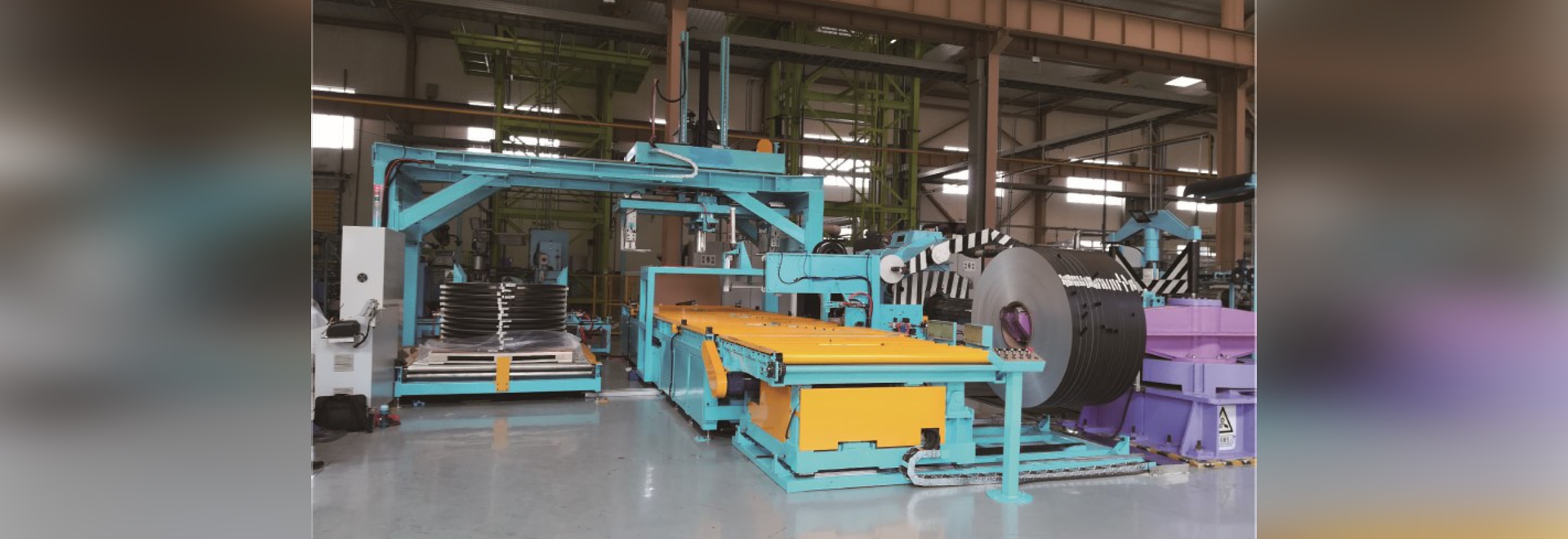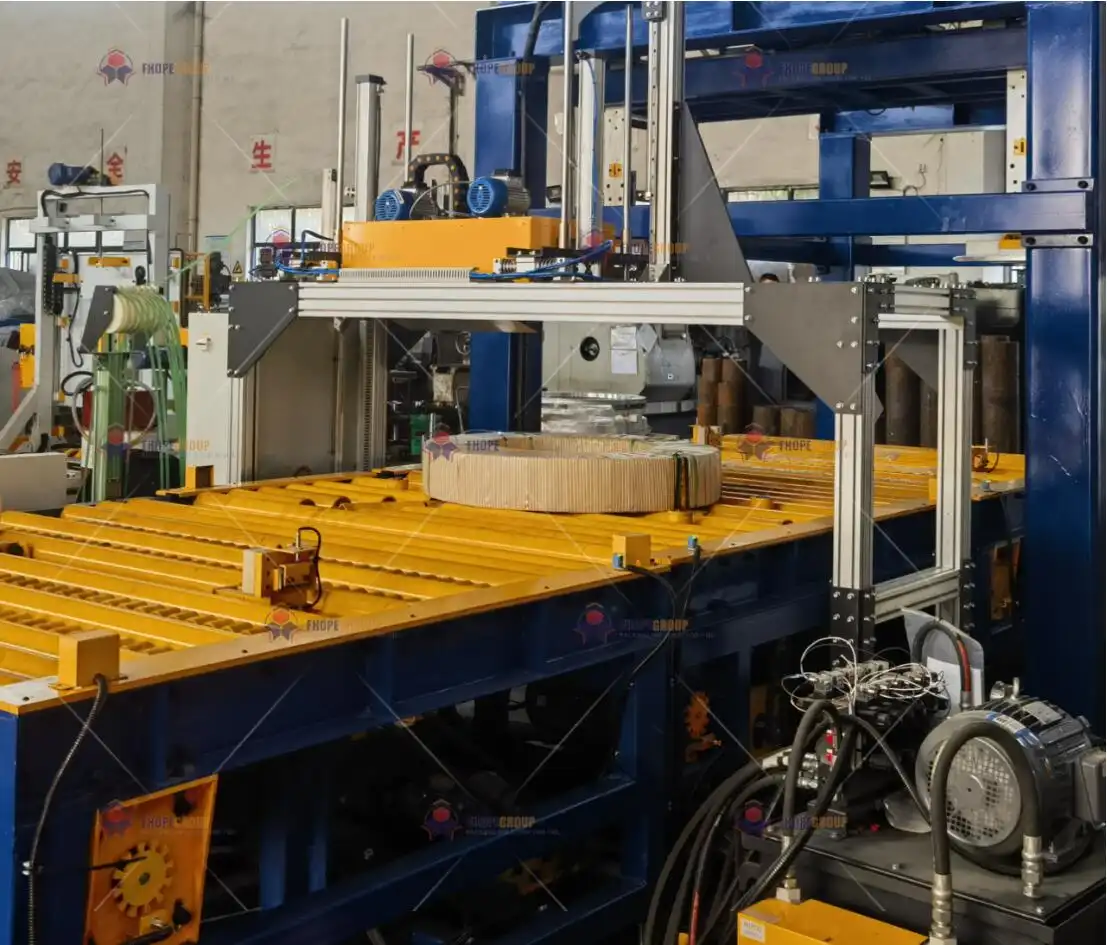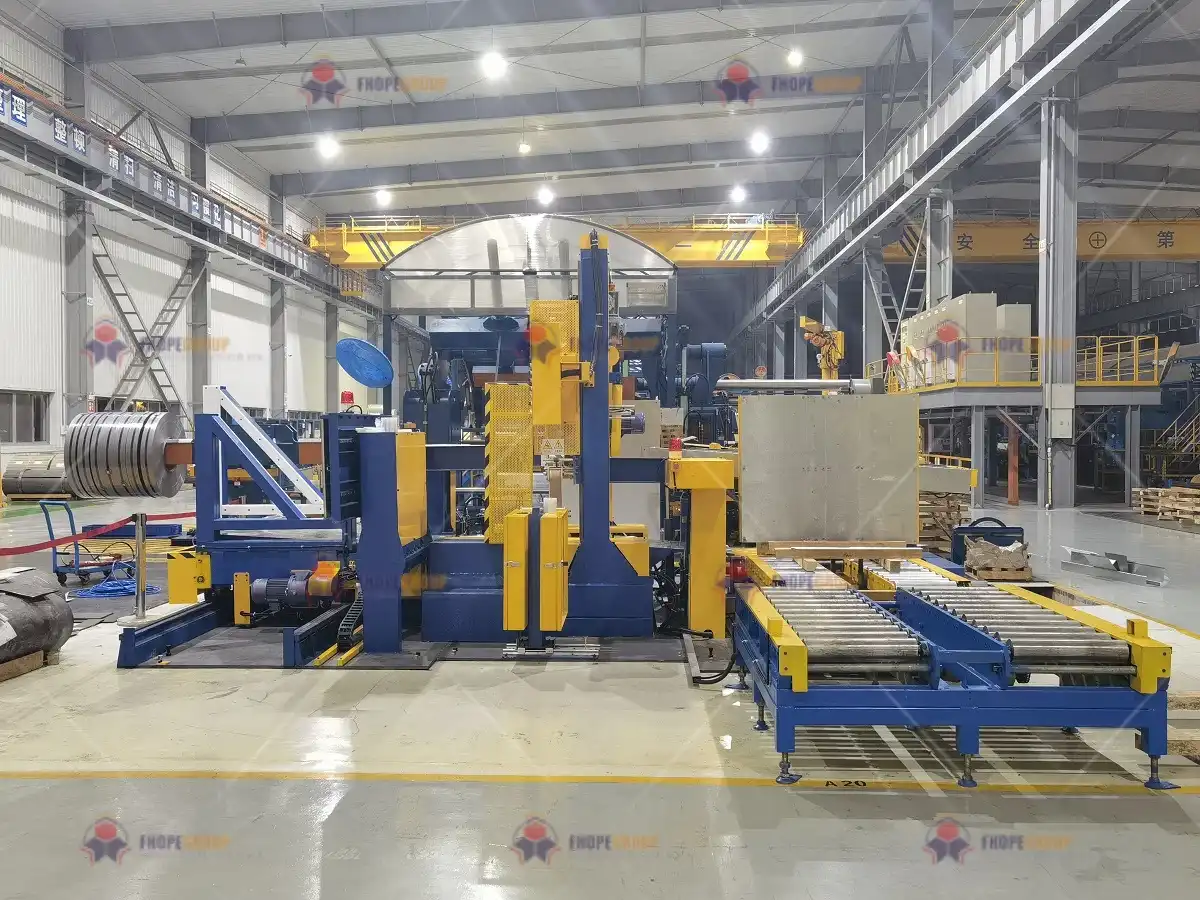Your steel mill in Malaysia produces world-class coils. But the journey from your factory floor to an international customer is long and dangerous. You face the constant threat of corrosive sea air and the rough handling of global shipping. A single damaged or rusted coil arriving at your customer's door can erase your profit margin on that shipment and damage your hard-earned reputation. It’s a persistent worry that keeps mill owners up at night.
A packaging line designed for Malaysian steel mills protects coils for export by using an automated, multi-stage process. This includes applying VCI anti-rust materials to combat humidity, wrapping the coil in multiple protective layers like stretch film and woven sheets, and securing it with robust steel or PET strapping. This total solution ensures your coils arrive damage-free and rust-free, safeguarding your product quality and customer relationships.

I have spent my entire career in the packing machine industry. I started on the factory floor and eventually built my own company, SHJLPACK. I’ve seen firsthand how mills invest millions in producing perfect steel, only to see their efforts wasted in the final 100 meters of their production line—the packaging area. But the right packaging line isn't a cost center. It's a profit protector. It's a strategic asset that solves many of the challenges you face today, from rising costs to market demands. Let’s explore how.
How can an automated packaging line combat rising labor and material costs in Malaysia?
In Malaysia, like many other places, finding and retaining skilled labor is getting tougher and more expensive. You rely on your team for manual packing, but this process is often slow, inconsistent, and creates bottlenecks that can bring your entire shipping schedule to a halt. You end up paying for overtime, dealing with high staff turnover, and watching packing materials get wasted due to human error. This constant drain on resources makes it difficult to control your operational costs and stay competitive.
An automated packaging line is a direct answer to these challenges. It significantly reduces your dependence on manual labor for repetitive tasks. It also minimizes material waste by applying film, paper, and straps with machine precision. This boosts your throughput, lowers your operational expenses, and gives you a predictable, efficient packaging process that you can count on, shift after shift.

When I started my journey as an engineer, I saw how much depended on the packing crew. Their speed determined the plant's output. Their skill determined the safety of the product. But this created a huge vulnerability. An automated line changes this dynamic completely. It transforms your packaging from a manual, variable process into a controlled, industrial one. Let's break down the real-world impact.
Direct Labor Cost Reduction
The most immediate benefit is the reduction in labor. A fully automated packaging line can often do the work of three to five workers per shift. These are not just savings on salaries. This also reduces costs associated with recruitment, training, benefits, and HR management. It frees up your valuable human resources. Your team members can be retrained and reassigned to more complex, higher-value roles like quality control, machine supervision, or maintenance, where their skills can make a bigger impact. I remember a client in Southeast Asia whose packing station was their biggest bottleneck. After we installed an automated line, they reassigned five workers per shift. The morale boost was immediate because the team was now focused on managing a modern system, not on physically exhausting labor.
Optimizing Material Consumption
Manual packing is inherently wasteful. One worker might use too much stretch film, while another might not apply the VCI paper correctly, leading to waste and potential quality issues. An automated system eliminates this guesswork. You can program the exact number of wrapping layers, the precise tension of the stretch film, and the specific amount of overlap for VCI paper. The machine executes these parameters perfectly for every single coil. This level of precision can lead to significant savings. A reduction of 15-20% in film and paper consumption is common. Over a year, this adds up to a massive cost saving that goes directly to your bottom line.
Analysis of Cost Savings
| Cost Factor | Manual Packaging Process | Automated Packaging Line | Impact |
|---|---|---|---|
| Labor | 4-6 operators per shift | 1-2 operators/supervisors | 75% reduction in direct labor needs |
| Material Waste | 10-15% average waste | <3% controlled waste | Significant reduction in consumable costs |
| Throughput | Limited by worker speed | Consistent, high-speed output | Eliminates bottlenecks, increases shipments |
| Consistency | Varies by operator/shift | Identical packaging for every coil | Reduces quality claims and rework |
| Safety | Risk of strains, repetitive injuries | Minimal manual handling | Lower insurance costs, fewer accidents |
What specific packaging features are crucial for protecting steel coils during sea freight from Malaysia?
You’ve done everything right. Your steel coil is flawless as it leaves the production line. You load it onto a truck, and it begins its long journey to a port, then across the ocean. Weeks later, you get a call from your client. The coil has arrived, but it's covered in rust and has dents along the edges from rough handling. Your customer rejects the shipment. Now you are facing a costly claim, reverse logistics headaches, and a damaged relationship with a valuable client. The combination of Malaysia's humid climate and the harsh realities of sea freight is a brutal test for any packaging.
To win this battle, you need a packaging system armed with specific features designed for this exact environment. It’s not about just covering the coil; it’s about creating a multi-layered fortress against moisture and physical impact. The right features ensure your product is as perfect when it's unwrapped by your customer as it was when you made it.

As an engineer, I think of this as building a defense system. Each layer has a specific job. If one layer fails, the next one must hold. For export from a tropical climate like Malaysia, this system has to be robust. You are fighting against salt, humidity, condensation inside containers, and impacts from cranes and forklifts. Here is how we build that defense.
The First Line of Defense: Anti-Corrosion
Corrosion, or rust, is your primary enemy. Steel and humid, salty air are a recipe for rust. The key weapon here is Vapor Corrosion Inhibitor, or VCI. VCI technology is integrated into paper or film. When a coil is wrapped in VCI material, the inhibitors vaporize and form a microscopic, invisible layer of protection on the surface of the steel. This layer blocks the electro-chemical reaction that causes rust.
- VCI Paper vs. VCI Film: VCI paper is often preferred as the first layer touching the steel because it also absorbs any trapped condensation. VCI film can be used as an outer layer to provide both a moisture barrier and anti-corrosion properties. An automated system ensures this first, critical layer is applied smoothly and without gaps.
Creating a Physical Barrier: Wrapping and Protection
Once the coil is protected from corrosion, you need to shield it from water and physical damage. This is a multi-step process.
- Waterproof Wrapping: After the VCI layer, the coil is typically wrapped in multiple layers of stretch film. A high-quality stretch film creates a tight, cocoon-like seal that prevents water from getting in. After that, a final, more durable layer of woven fabric (like HDPE) or waterproof kraft paper is applied. This outer layer protects the inner stretch film from being punctured or torn.
- Physical Damage Protectors: Coils are most vulnerable at their edges. An automated line can precisely place protective materials.
- ID/OD Protectors: These are hard rings made of cardboard, plastic, or steel that are placed on the inner and outer circumference of the coil. They prevent the strapping from cutting into the coil and protect the edges from impact.
- Side Plates: Metal or hardboard discs are placed on the sides of the coil to provide a flat, stable surface for stacking and to prevent side impacts.
Ensuring Structural Integrity: Strapping
Strapping is the final step that holds the entire package together. It must be strong enough to keep the coil secure and the protective layers in place.
| Feature | Purpose | Why It's Crucial for Malaysia Export |
|---|---|---|
| VCI Paper/Film | Anti-corrosion | Neutralizes the high humidity and salty sea air. |
| Stretch Film Wrap | Waterproofing | Creates a tight seal against rain and sea spray. |
| Outer Woven/HDPE Wrap | Puncture Resistance | Protects the inner layers from damage during handling. |
| ID/OD Protectors | Edge Protection | Prevents strapping and impact damage to coil edges. |
| Circumferential Strapping | Secures the package | Keeps the wrapping layers tight and prevents the coil from unspooling. |
| Through-the-Eye Strapping | Lifting & Handling | Provides secure points for lifting and prevents the coil from shifting during transit. |
How does a modern packaging line integrate with a mill's existing digital transformation goals?
Your steel mill is embracing the future. You are investing in a Manufacturing Execution System (MES) to track production. You are using data analytics to find efficiencies. Your facility is becoming a smart factory. But your packaging area remains a "black box." It's a place of manual processes and paperwork, completely disconnected from your digital ecosystem. This creates a critical blind spot. You cannot track your final product's status in real-time. You don't know the true efficiency of your packing process. And you lose product traceability at the most critical hand-off point: shipping.
A modern, automated packaging line is not just a mechanical system; it's a data-rich, intelligent asset. It is designed to connect seamlessly with your factory's digital infrastructure. It becomes a key node in your Industry 4.0 strategy, feeding valuable data into your MES and providing the visibility you need to manage your entire operation, from furnace to final shipment.

When I speak with forward-thinking mill owners like Javier, the conversation quickly moves beyond mechanics and into data. They don't just want a machine that wraps coils; they want a system that talks to their other systems. They want to eliminate information silos. A packaging line that can communicate with the mill's "brain" (the MES) is no longer a futuristic idea; it is a practical and necessary tool for modern steel manufacturing.
Connecting to Your Manufacturing Execution System (MES)
The integration between the packaging line and the MES is a two-way street. This is often called Level 2 or Level 3 automation.
- MES to Packaging Line: The MES sends information about the incoming coil to the packaging line's PLC (Programmable Logic Controller). This data includes the coil's unique ID, weight, width, and outer diameter. It can also include the customer's specific packaging recipe. The packaging line then automatically adjusts its settings—like the position of the wrapper or the number of straps—for that specific coil without any manual input.
- Packaging Line to MES: Once the packaging process is complete, the line sends data back to the MES. This confirms that the coil has been successfully packaged according to the recipe. It also sends back valuable production data, such as the cycle time, the amount of film and paper used, and the number of straps applied. This closes the information loop and creates a complete digital record for every coil.
Data for Better Decision Making
With this data, you can move from guessing to knowing. As a plant manager, you can now see a dashboard with Key Performance Indicators (KPIs) for your packaging area.
| Data Point Collected | How It Helps Management |
|---|---|
| Coil ID & Timestamp | Provides 100% traceability from production to shipment. |
| Cycle Time per Coil | Measures Overall Equipment Effectiveness (OEE) and identifies bottlenecks. |
| Material Consumed | Allows for precise cost-per-coil tracking and inventory management. |
| Fault/Error Codes | Enables quick troubleshooting and analysis of recurring problems. |
| Operator ID | Tracks performance and identifies needs for additional training. |
This information helps you answer critical questions. Which shift is most efficient? Are we using more stretch film than planned? Is a specific machine component causing frequent, minor stops? This is the kind of business intelligence that drives real cost reduction and efficiency improvements.
Enabling Predictive Maintenance
This is one of the most powerful benefits of integration. Modern packaging lines are equipped with IoT sensors that monitor the health of critical components. These sensors track motor vibration, bearing temperature, hydraulic pressure, and cycle counts. This data is fed into a maintenance module or your central system. Instead of waiting for a machine to break down and halt your entire shipping operation, the system can predict a potential failure. It can generate an alert, for example, that "Motor 3 has shown increased vibration for 48 hours and is due for inspection." This allows your maintenance team to schedule repairs during planned downtime, a key factor in achieving goals like 95% equipment uptime.
What is the ROI of upgrading an aging packaging line in a Malaysian steel mill?
You look at your aging packaging line. It has served you for over 15 years, but now it's a constant source of problems. Breakdowns are frequent. It’s slow, inefficient, and requires constant manual supervision. Every time it stops, your entire shipping operation grinds to a halt. You are paying more and more for maintenance parts and labor, you are losing valuable production time, and you are constantly at risk of delaying customer deliveries. The cost of doing nothing is getting higher every single day, quietly eating away at your profits.
Upgrading to a new, automated packaging line is a significant capital investment. But it should not be viewed as just an expense. It is a strategic investment with a clear and often surprisingly rapid Return on Investment (ROI). The financial benefits are tangible, measurable, and go far beyond just wrapping coils faster. By analyzing the savings in labor, materials, maintenance, and throughput, you can build a powerful business case that shows a clear payback period.

I've had this conversation with many mill owners. They are rightly focused on the numbers. So, let’s do the math. When we break it down, the path to a positive ROI becomes very clear. I once worked with a client whose finance director was very skeptical about the upfront cost. We sat down together, not as a salesperson and a client, but as two engineers looking at a problem. We mapped out his current costs versus the projected performance of the new line. The numbers spoke for themselves. The upgrade wasn't just a good idea; it was a financial necessity for their future growth.
Calculating the 'Return': Your Annual Savings
The "Return" in ROI comes from several areas of direct and indirect cost savings. To build your business case, you need to quantify these.
- Labor Savings: Calculate the annual cost of the operators who will be reassigned. (Number of operators x shifts x annual salary & benefits).
- Material Savings: Estimate the reduction in consumable usage. (Current annual cost of film, paper, straps x estimated waste reduction %, e.g., 15%).
- Maintenance Savings: Compare the annual maintenance cost of the old line (parts, labor, service calls) with the minimal maintenance cost of a new line under warranty.
- Throughput Gains: This is a powerful one. Calculate the value of increased capacity. (Additional coils per day x profit per coil). Or, calculate the savings from eliminating overtime needed to meet shipping deadlines.
- Reduced Damage Claims: Estimate the annual cost of product claims, returns, and discounts due to packaging failures. A modern line can reduce this to near zero.
Understanding the 'Investment': The Total Cost
The "Investment" is more than just the price on the quotation. A realistic calculation includes:
- Machine Cost: The purchase price of the new packaging line.
- Installation & Commissioning: The cost for engineers to install, test, and start up the equipment.
- Training: The cost to train your operators and maintenance staff.
- Infrastructure: Any necessary modifications to your plant floor, like concrete foundations or utility connections.
The Payback Period and Beyond: A Sample Calculation
The simplest ROI metric is the payback period.
Payback Period (Years) = Total Investment / Total Annual Savings
Let's use a conservative example for a Malaysian mill:
| Item | Calculation | Value (MYR) |
|---|---|---|
| Total Investment | (Machine + Installation + Training) | 1,500,000 |
| Annual Labor Savings | (4 operators x 60,000 MYR/year) | 240,000 |
| Annual Material Savings | (500,000 MYR in materials x 15% reduction) | 75,000 |
| Annual Maintenance Savings | (Reduced parts and labor) | 50,000 |
| Annual Throughput Gain | (Value of eliminating bottlenecks) | 150,000 |
| Total Annual Savings | (Sum of all savings) | 515,000 |
| Payback Period | (1,500,000 / 515,000) | 2.9 Years |
A payback period of under three years for major industrial equipment is a very strong financial justification. And after those 2.9 years, the 515,000 MYR in savings continues to flow directly to your profit margin every year for the life of the machine. The long-term benefits are even greater: improved safety, higher customer satisfaction, and a facility that is ready for the future.
Conclusion
A modern packaging line is vital for Malaysian steel exporters. It protects products, cuts costs, and secures your place in the global market.
